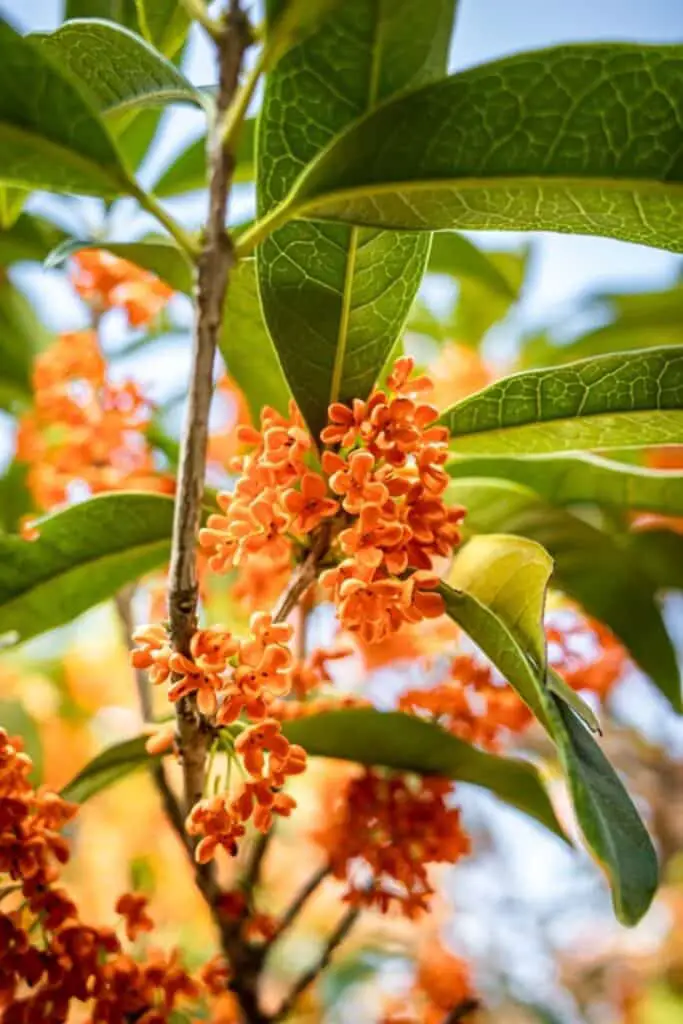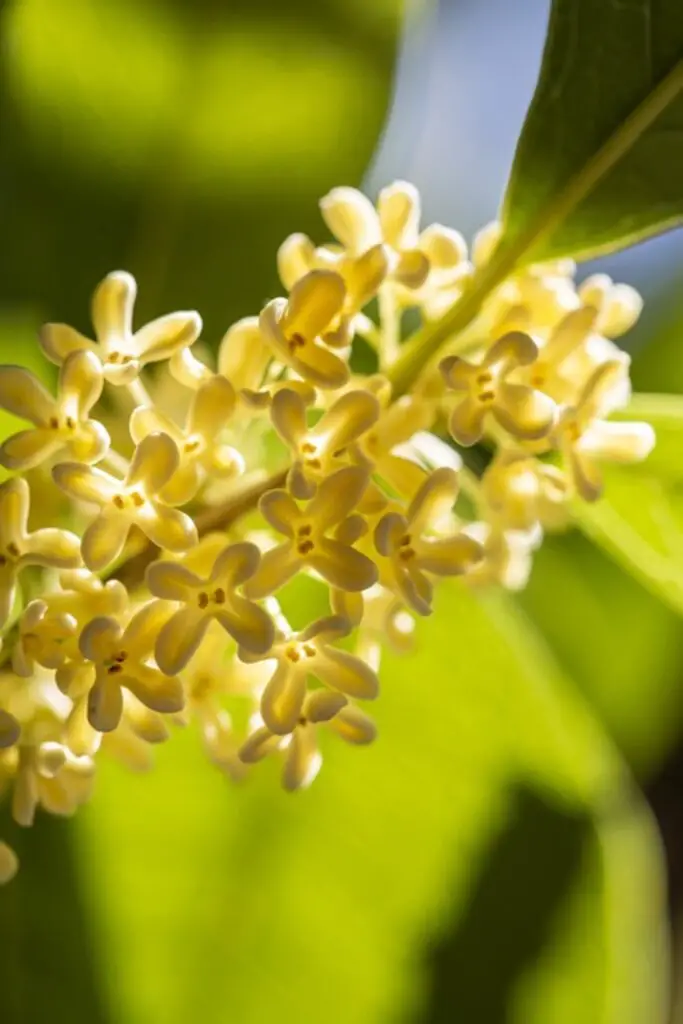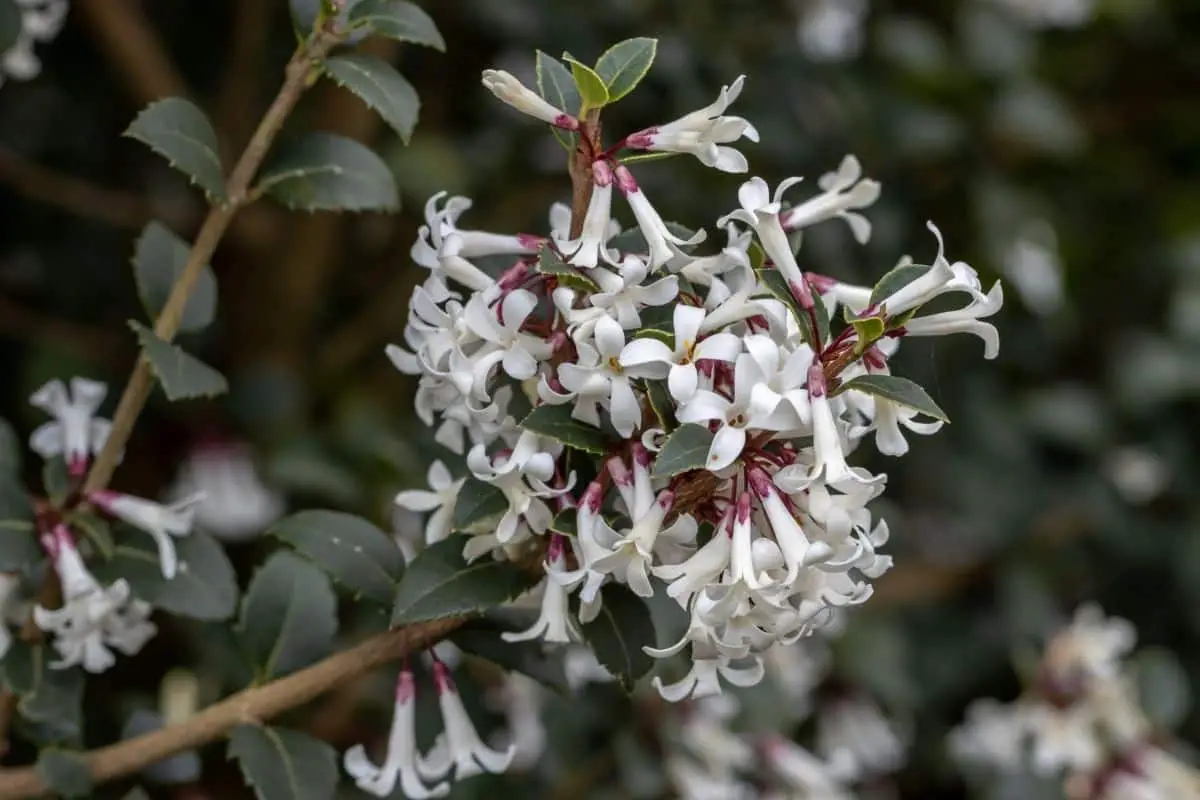Now here is another flower whose name seems very peculiar at first. If you look at the osmanthus tree closely, it slightly resembles a flower most popular during the Christmas season. Guessed it yet? It looks a lot like the Holly plant with its bright berries, delicate flowers, and holly-like leaves!
Osmanthus plants are often used in many fields such as in ornamentals, culinary, and traditional folkloric medicine. It also has the most fragrant flowers and quite an interesting flower meaning and symbolism behind it.
For one, a white osmanthus flower means bounty and prosperity. A red osmanthus symbolizes protection and an orange one represents happiness.
History of Osmanthus Trees
The rise to floral fame of the osmanthus dates back to the 18th century. During this time, the flowers were first introduced to Europe from across the seas from Southeast Asia by French botanist Jean Marie Delavay.
It was then defined as an evergreen shrub or tree with bisexual flowers closely resembling hollies. These flowering plants have small clusters of flowers that are commonly cultivated for their edible fruits and leaves. Osmanthus flowers bloom under full sun conditions.
The osmanthus shrubs belong to the small genus of Osmanthus of the Oleaceae or olive family. It is so small that in fact there are only 15 known species of this genus known today. Its genus name comes from the Greek words osma or osme meaning fragrant and anthos meaning flower. Greek osma also meant quantity. Quite literally, the genus name means a fragrant flower – bet you can already guess what this is used for!
These fragrant Osmanthus blossoms are known by other quaint common names such as Tea Olive, Sweet Olive, or Devilwood. Most of these species are also native to the eastern parts of North America, regions of Mexico and Southeast Asia, and as well as Hawaii and New Caledonia.
A known osmanthus flower faq is that there are only 15 species. Here are the top 5 garden favorites of this fragrant plant! The Sweet Olive (Osmanthus fragrans), the Orange Osmanthus (Osmanthus aurantiaca), the False Holly (Osmanthus heterophylla), the Delavay Osmanthus (Osmanthus delavayi), and the Devilwood (Osmanthus americanus).
Symbolism of Osmanthus Blossoms
In historic Chinese traditions and cultures, the world of flowers has very deep symbolism in the art of Feng Shui. These flowers symbolize good luck, status promotion, and literary success according to Chinese beliefs.
Additionally, Chinese customs believe that Sweet Olives are symbolic of honor and preciousness. It is an embodiment of nobility and the wishful thinking of noble sons.
Taking a look at Chinese traditional arts, a Sweet Olive flower is a euphemism for life, true love, sex, and death.

Meaning of Osmanthus Flowers
There is more than just one osmanthus flower meaning out there. According to Chinese Feng Shui, these sweet scented flowers symbolize good luck and well wishes.
In the language of flowers, an osmanthus flower meaning is quite similar to the Chinese one. It also has such a unique beauty paired with a sweet fragrance that it stands for nothing but blessings and good fortune.
What does a White Osmanthus Flower Mean?
Clusters of intricate white Sweet Olive flowers denote the meaning of prosperity and bounty. Seeing these during its first bloom will definitely be a sign of fortune and positive outcomes.
These white flowers also have another special meaning. It is a common traditional symbol of nobility and is most associated with noble children.
What does a Red Osmanthus Blossom Symbolize?
Red is indeed a very powerful color in Chinese tradition and Feng Shui. A red osmanthus flower is symbolic of protection – not only from evil and darkness but most especially from bad luck!
What does an Orange Osmanthus Floret Represent?
Orange flowers always hold such a bright and bubbly meaning to it. In fact, orange osmanthus flowers not only indicate bounty but also bountiful and glorious happiness! A happiness which may be because of the incoming prosperity and good luck!
What does a Yellow Osmanthus Flower Mean?
A yellow osmanthus flower is quite a special one. It symbolizes a non-romantic or platonic love. It also stands for affection, confidence, enjoyment, and satisfaction.
What is the Cultural Significance of an Osmanthus Bloom?
Southeast Asian countries such as the likes of Japan and China, have a very deep and rich cultural history for the osmanthus. Although, China has a more popularized practice for it. In Japan, these flowers are called the usugi-mokusei while the Chinese refer to these flowers as the kwai-fan.
In Chinese culture, a very special day time celebrates the osmanthus. In Hangzhou, China, an osmanthus is called the City flower. Three Chinese monks in the province planted the shrubs near their Buddhist temples so that the intoxicating aroma is released every Fall.
Since ancient times during the Song Dynasty, the poet Yang Wanli wrote about the osmanthus’ strong fragrance referencing how difficult it was to believe it was from nature and not the moon in heaven. But nonetheless, people still believed the flowers were tied with the moon.
And during the season of Autumn when the air turns cold and the daylight shortens, the famous Chinese Moon Festival or Osmanthus Festival is celebrated. Festivities are held during the month of September when the flowers are in bloom and used as the festival’s official floral motif.
During the festival one’s family sets up a small table offered with fruits and other goods to sacrifice to the moon praying for prosperity.
According to the lunar myth about the festival, the celebration is actually in honor of the fragrance of its flowers – particularly the white Sweet Olive ones! During the time its flowers bloom, a bountiful incoming harvest and moon divine blessings – or so as the Chinese myth says.
In line with the Osmanthus festive celebration, there is a legend speaking about the flower and the moon. The Moon Palace legends tells a tale about the Jade Emperor who was blessed with a chance to visit the moon. A priest paved a silver bridge heading to the palace where the emperor found the flower and its intoxicating scent.
During his visit, he caught a glimpse of the stunning Moon lady and was entertained by dancers while eating osmanthus-sweetened moon cakes. It is why the Chinese today have traditional pastries and why they eat moon cakes during important festivals.
What is a Chinese festival without the food delicacies right? During the Moon Festival, Sweet Olive blossoms are used to create several tasty foods and drinks. These include an osmanthus steamed cake, crafted fermented wine, infused sweet osmanthus tea, and other numerous osmanthus flavored dishes!

What is the Folktale Associated with an Osmanthus Flower?
Since these flowers are well celebrated during the Osmanthus Festival, you just have to know the legend as to why this happens to be so! According to the lunar legend, the flowers used to only grow on the face of the full moon and that it was not alone.
Wu Gang, a mythical hero known as the Chinese Sisyphus, was bound to endlessly cut the tree down daily but to his surprise, grew the exact equal amount the tree was cut down for! Some say this was his divine punishment for upsetting the gods with either his arrogance or laziness.
Another Chinese folklore talks about abundance of the osmanthus and how it was associated with fertility. It was believed that bestowing an osmanthus with pomegranate meant a new family after giving birth to many children will all grow to be noble.
What does an Osmanthus Flower Tattoo Symbolize?
In the Chinese arts and traditional Feng Shui, it is no doubt that all these flowers have a positive chi to them. So it is practically good luck to get this floral tattoo! Not only that but this design also embodies good traits such as nobility and honor. Such traits are not only exclusive as personal qualities, but also in words and actions.
Uses of Osmanthus Plants
You read it right – the collective term for an osmanthus is osmanthuses! Apart from being an ornamental fragrant olive plant, it is also used in various economic fields such as in culinary, perfumery, and folkloric medicine.
The plant’s berry fruits are safe to eat while the leaves of Sweet Olive are used to create osmanthus tea (Gui Hua) with a sweet scent. Some say that the infusion with these leaves has a sweet apricot-like taste! Traditionally in Japan and China, the flower is highly valued by tea connoisseurs. It is famously used as a tea additive to enhance the natural fruitiness of the finest green and black teas.
The Chinese have also developed a practice in extracting the floral oils for their fragrance. Not only does it add that sweet apricot-like scent to perfumes, but it also can be used in other body products such as creams, soaps, and lotions.
Aside from its oil used in cosmetic and beauty products, the Chinese also have a folkloric medicinal application as a medical herb. The extracted oil is considered as China’s top 10 traditional flowers used in creating antidepressant blends of medication. The bark is also claimed to have properties that treats boils.
A word of warning that it’s a must to always consult a medical professional before using this plant or any part of it for medical purposes.
~ image source: depositphotos/Tom Cardrick

